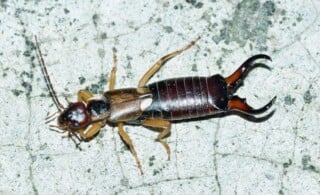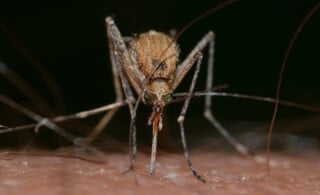
The best way to get rid of fleas in your yard is to use diatomaceous earth. The process involves cleaning, mowing and applying diatomaceous earth. You might also consider using nematodes or flea sprays.
Controlling and preventing fleas around your home or on your furry friends doesn’t mean you’re finally free of these pesky pests. Unfortunately, your yard makes a perfect home for them too. Fleas usually hide in moist areas of your yard that don’t have direct sunlight exposure. If not controlled, they could soon find their way into your home.
On This Page:
1. Clean Your Yard
It’s vital to take the time to clean your yard. Remove debris, including twigs and dead leaves, from flower beds and under the bushes. Prune your shrubs and plants to expose most of the shady areas to sunlight.
The aim is to eliminate any moist areas that can harbor fleas. Flea larva will quickly die in dry, sunny conditions.
While cleaning your yard helps to control fleas, it might also lead to other undesirable effects. For example, cleaning leaves and twigs deny your garden natural nutrients.
Ready to start your Flea Removal?
Find Pros2. Mow Your Lawn
Areas with tall grass make the perfect hiding spots for fleas because they are damp and shady. So, you should also mow your lawn to expose the surface to direct sunlight. The grass length should be about 2 to 4 inches long. Grass that’s too short will keep away ants or spiders that eat fleas.
After mowing, make sure you remove and dispose of the grass clippings. Leaving clippings on your lawn creates damp spots that allow fleas to burrow and breed.
3. Apply Diatomaceous Earth
Once you have mowed and cleaned your yard, you can apply diatomaceous earth, which is the best way to treat the yard for fleas. It works by dehydrating fleas, which eventually die.
You’ll need to sprinkle it over the areas where your pets like lying down. Food-grade diatomaceous earth isn’t effective when mixed with water. Ensure there is no water in your yard, and apply it when there’s no rain.
However, there are different formulations of diatomaceous earth. You can also get one that’s in liquid form for effortless spraying.
While this fine powder is non-toxic to pets and humans, it can irritate your nasal passages and nose, leading to cough and shortness of breath. It’s safe to plant roots though.
4. Spread Nematodes
When you’re looking for the best thing to kill fleas in the yard, you should consider using nematodes. They are microscopic worms and work by feeding on larvae, pupae and eggs of fleas. They offer a natural and non-toxic way of killing fleas in your yard. Nematodes kill fleas before they become adults.
You can get nematodes from your local store. You’ll need to mix them with water before spraying them in your yard. Here is what you need to do:
- Apply nematodes in the evening.
- Water the area before and after application.
- Focus the application around shrubs and on shaded areas.
As beneficial worms, nematodes are safe to plants, pets, grass and humans. Even if ingested, they’ll quickly die off because they can’t survive in temperatures over 86 degrees Fahrenheit. They’re ideal for lawn and garden applications, allowing you to stop the problem before it starts.
However, nematodes can invade root nodules, making plants look wilted or yellowed. Affected food crops will usually deliver poor yields.

5. Use Flea Spray
Another great way to get rid of fleas in the yard is by using insecticide or pesticide. Be sure to find an insecticide that contains pyriproxyfen, which stops fleas from developing into adults.
When using flea spray, you don’t need to spray your whole yard. Remember, fleas avoid areas with direct sunlight. Instead, focus on shady, moist areas, particularly spots where your pets love resting.
Also, keep in mind that chemical sprays are likely to harm your pets. Prevent them from accessing the yard for six to 24 hours to allow the spray to dry and clear. If you need help, talk to flea exterminators in your area to help you handle the infestation.
Final Thoughts
Having fleas in your yard means they’ll eventually get into your home. So, when you clean your home and treat your pets for fleas, remember to clean, mow and treat your yard, too. Be sure not to overwater your lawn because these bugs love moisture.
Fleas are nocturnal insects, and they’ll take up residence in any moist, shady areas of your yard. It’s also vital to patch up holes in your fence to prevent stray or neighboring dogs from entering your yard. Using cedar wood chips can also help to repel any new fleas.
 Earwig Pest Control
Earwig Pest Control  Flea Control & Prevention
Flea Control & Prevention  An Eco-Friendly Yard: How to Keep Bugs, Weeds, and Other Nuisances Out Without Harming the Planet
An Eco-Friendly Yard: How to Keep Bugs, Weeds, and Other Nuisances Out Without Harming the Planet  Itching for a Solution on Mosquito Control?
Itching for a Solution on Mosquito Control?  Got Gopher Control?
Got Gopher Control? 

Are You Familiar With This Topic? Share Your Experience.